engine oil INFINITI QX56 2007 Factory User Guide
[x] Cancel search | Manufacturer: INFINITI, Model Year: 2007, Model line: QX56, Model: INFINITI QX56 2007Pages: 3061, PDF Size: 64.56 MB
Page 122 of 3061
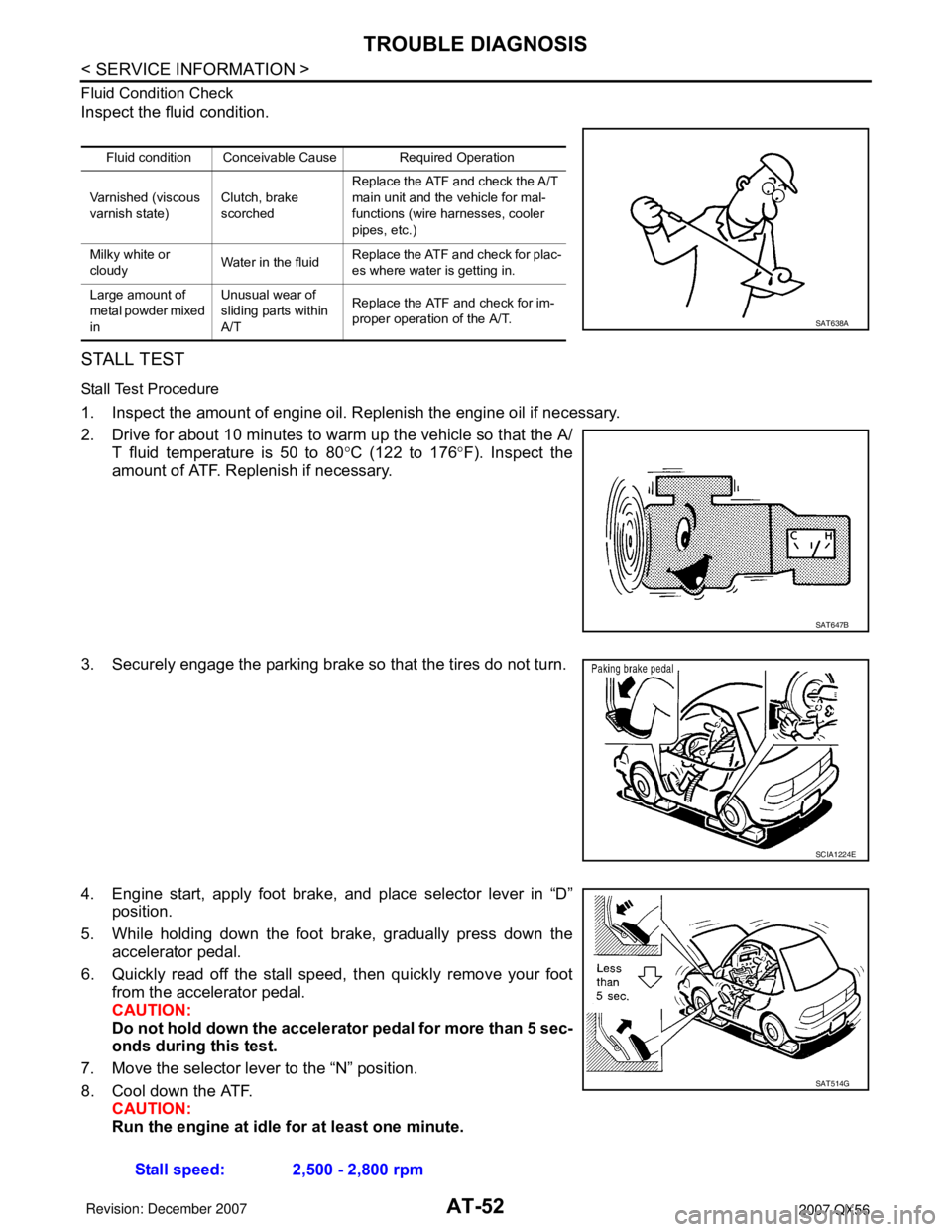
AT-52
< SERVICE INFORMATION >
TROUBLE DIAGNOSIS
Fluid Condition Check
Inspect the fluid condition.
STALL TEST
Stall Test Procedure
1. Inspect the amount of engine oil. Replenish the engine oil if necessary.
2. Drive for about 10 minutes to warm up the vehicle so that the A/
T fluid temperature is 50 to 80°C (122 to 176°F). Inspect the
amount of ATF. Replenish if necessary.
3. Securely engage the parking brake so that the tires do not turn.
4. Engine start, apply foot brake, and place selector lever in “D”
position.
5. While holding down the foot brake, gradually press down the
accelerator pedal.
6. Quickly read off the stall speed, then quickly remove your foot
from the accelerator pedal.
CAUTION:
Do not hold down the accelerator pedal for more than 5 sec-
onds during this test.
7. Move the selector lever to the “N” position.
8. Cool down the ATF.
CAUTION:
Run the engine at idle for at least one minute.
Fluid condition Conceivable Cause Required Operation
Varnished (viscous
varnish state)Clutch, brake
scorchedReplace the ATF and check the A/T
main unit and the vehicle for mal-
functions (wire harnesses, cooler
pipes, etc.)
Milky white or
cloudyWater in the fluidReplace the ATF and check for plac-
es where water is getting in.
Large amount of
metal powder mixed
inUnusual wear of
sliding parts within
A/TReplace the ATF and check for im-
proper operation of the A/T.
SAT638A
SAT647B
SCIA1224E
Stall speed: 2,500 - 2,800 rpm
SAT514G
Page 123 of 3061
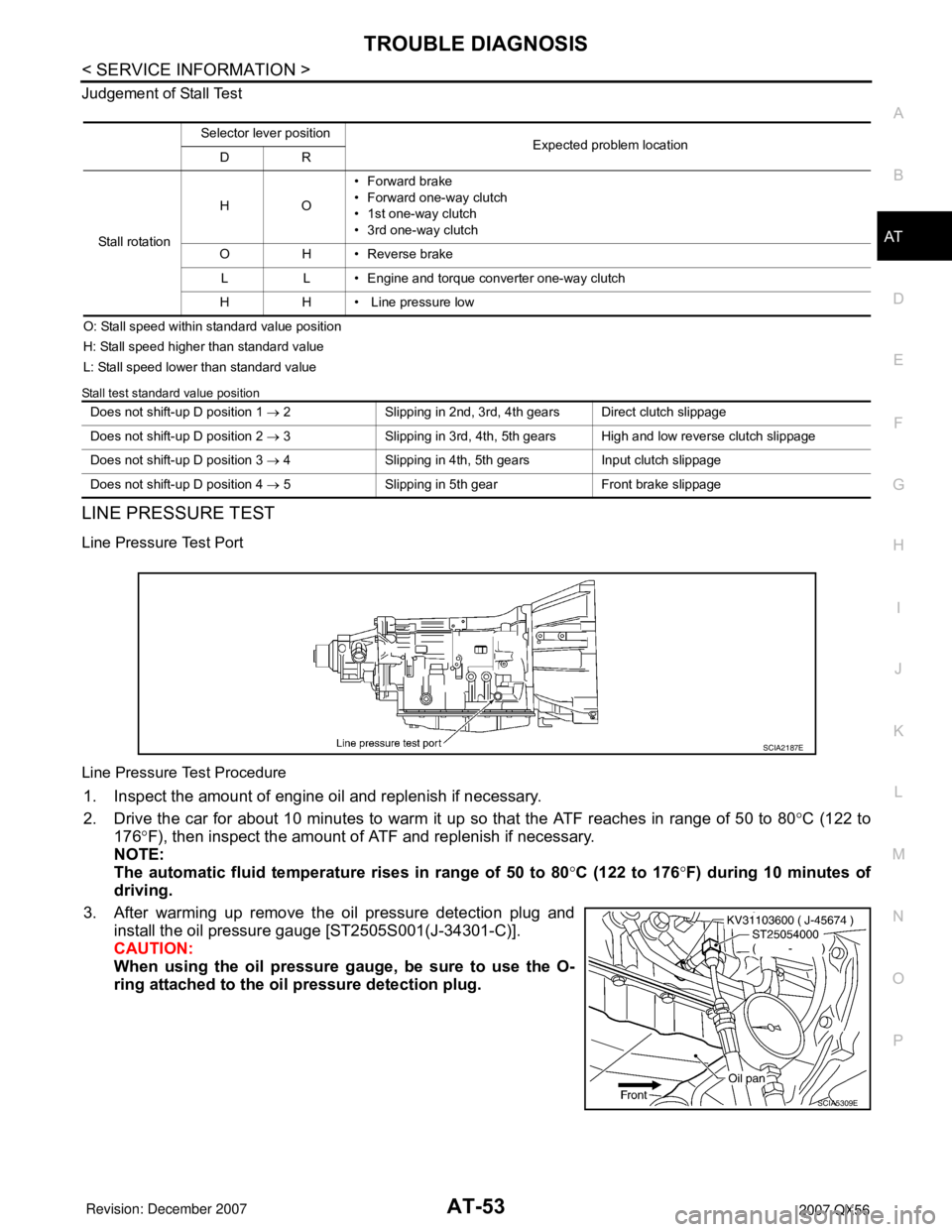
TROUBLE DIAGNOSIS
AT-53
< SERVICE INFORMATION >
D
E
F
G
H
I
J
K
L
MA
B
AT
N
O
P Judgement of Stall Test
O: Stall speed within standard value position
H: Stall speed higher than standard value
L: Stall speed lower than standard value
Stall test standard value position
LINE PRESSURE TEST
Line Pressure Test Port
Line Pressure Test Procedure
1. Inspect the amount of engine oil and replenish if necessary.
2. Drive the car for about 10 minutes to warm it up so that the ATF reaches in range of 50 to 80°C (122 to
176°F), then inspect the amount of ATF and replenish if necessary.
NOTE:
The automatic fluid temperature rises in range of 50 to 80°C (122 to 176°F) during 10 minutes of
driving.
3. After warming up remove the oil pressure detection plug and
install the oil pressure gauge [ST2505S001(J-34301-C)].
CAUTION:
When using the oil pressure gauge, be sure to use the O-
ring attached to the oil pressure detection plug.
Selector lever position
Expected problem location
DR
Stall rotation HO• Forward brake
• Forward one-way clutch
• 1st one-way clutch
• 3rd one-way clutch
O H • Reverse brake
L L • Engine and torque converter one-way clutch
H H • Line pressure low
Does not shift-up D position 1 → 2 Slipping in 2nd, 3rd, 4th gears Direct clutch slippage
Does not shift-up D position 2 → 3 Slipping in 3rd, 4th, 5th gears High and low reverse clutch slippage
Does not shift-up D position 3 → 4 Slipping in 4th, 5th gears Input clutch slippage
Does not shift-up D position 4 → 5 Slipping in 5th gear Front brake slippage
SCIA2187E
SCIA5309E
Page 124 of 3061
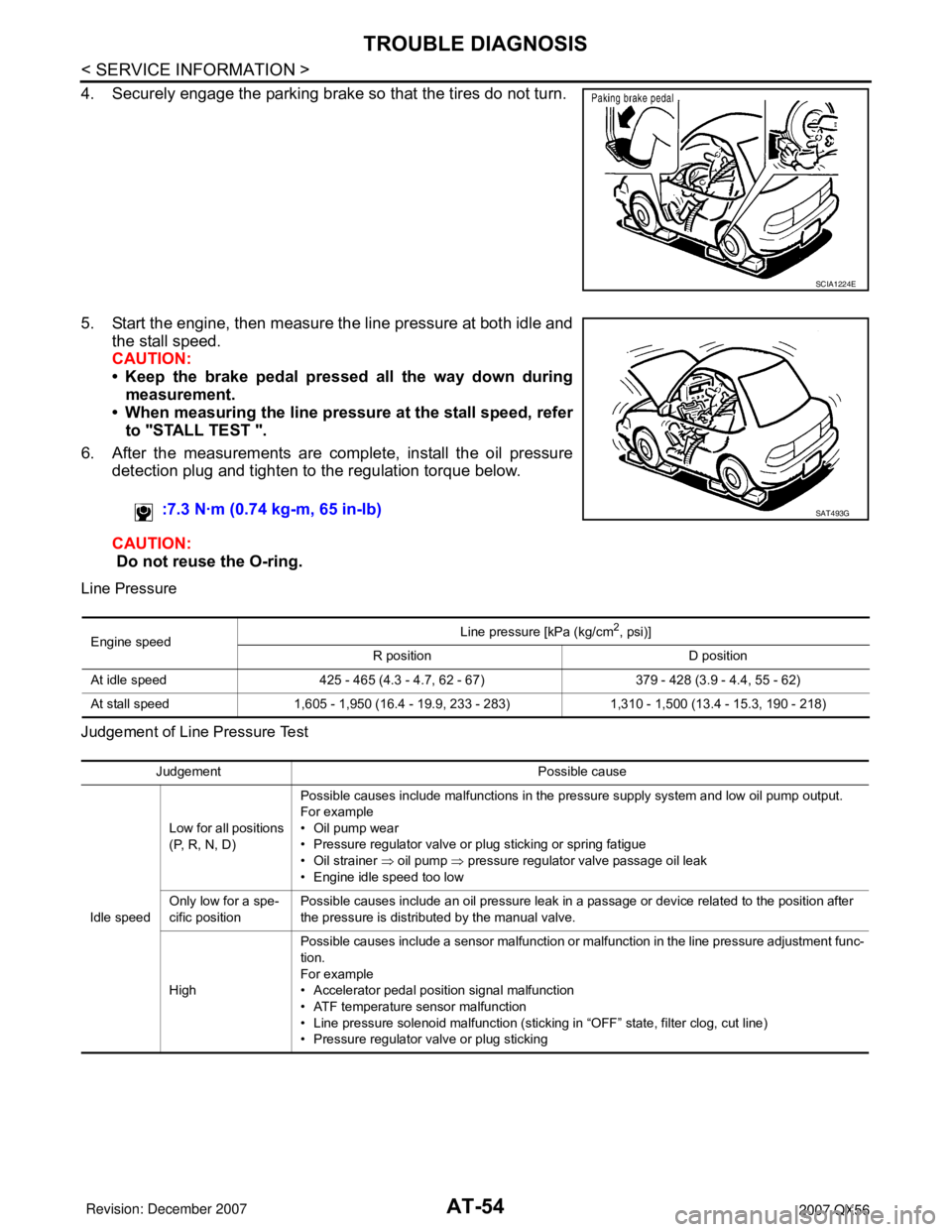
AT-54
< SERVICE INFORMATION >
TROUBLE DIAGNOSIS
4. Securely engage the parking brake so that the tires do not turn.
5. Start the engine, then measure the line pressure at both idle and
the stall speed.
CAUTION:
• Keep the brake pedal pressed all the way down during
measurement.
• When measuring the line pressure at the stall speed, refer
to "STALL TEST ".
6. After the measurements are complete, install the oil pressure
detection plug and tighten to the regulation torque below.
CAUTION:
Do not reuse the O-ring.
Line Pressure
Judgement of Line Pressure Test
SCIA1224E
:7.3 N·m (0.74 kg-m, 65 in-lb)SAT493G
Engine speedLine pressure [kPa (kg/cm
2, psi)]
R position D position
At idle speed 425 - 465 (4.3 - 4.7, 62 - 67) 379 - 428 (3.9 - 4.4, 55 - 62)
At stall speed 1,605 - 1,950 (16.4 - 19.9, 233 - 283) 1,310 - 1,500 (13.4 - 15.3, 190 - 218)
Judgement Possible cause
Idle speedLow for all positions
(P, R, N, D)Possible causes include malfunctions in the pressure supply system and low oil pump output.
For example
•Oil pump wear
• Pressure regulator valve or plug sticking or spring fatigue
• Oil strainer ⇒ oil pump ⇒ pressure regulator valve passage oil leak
• Engine idle speed too low
Only low for a spe-
cific positionPossible causes include an oil pressure leak in a passage or device related to the position after
the pressure is distributed by the manual valve.
HighPossible causes include a sensor malfunction or malfunction in the line pressure adjustment func-
tion.
For example
• Accelerator pedal position signal malfunction
• ATF temperature sensor malfunction
• Line pressure solenoid malfunction (sticking in “OFF” state, filter clog, cut line)
• Pressure regulator valve or plug sticking
Page 125 of 3061
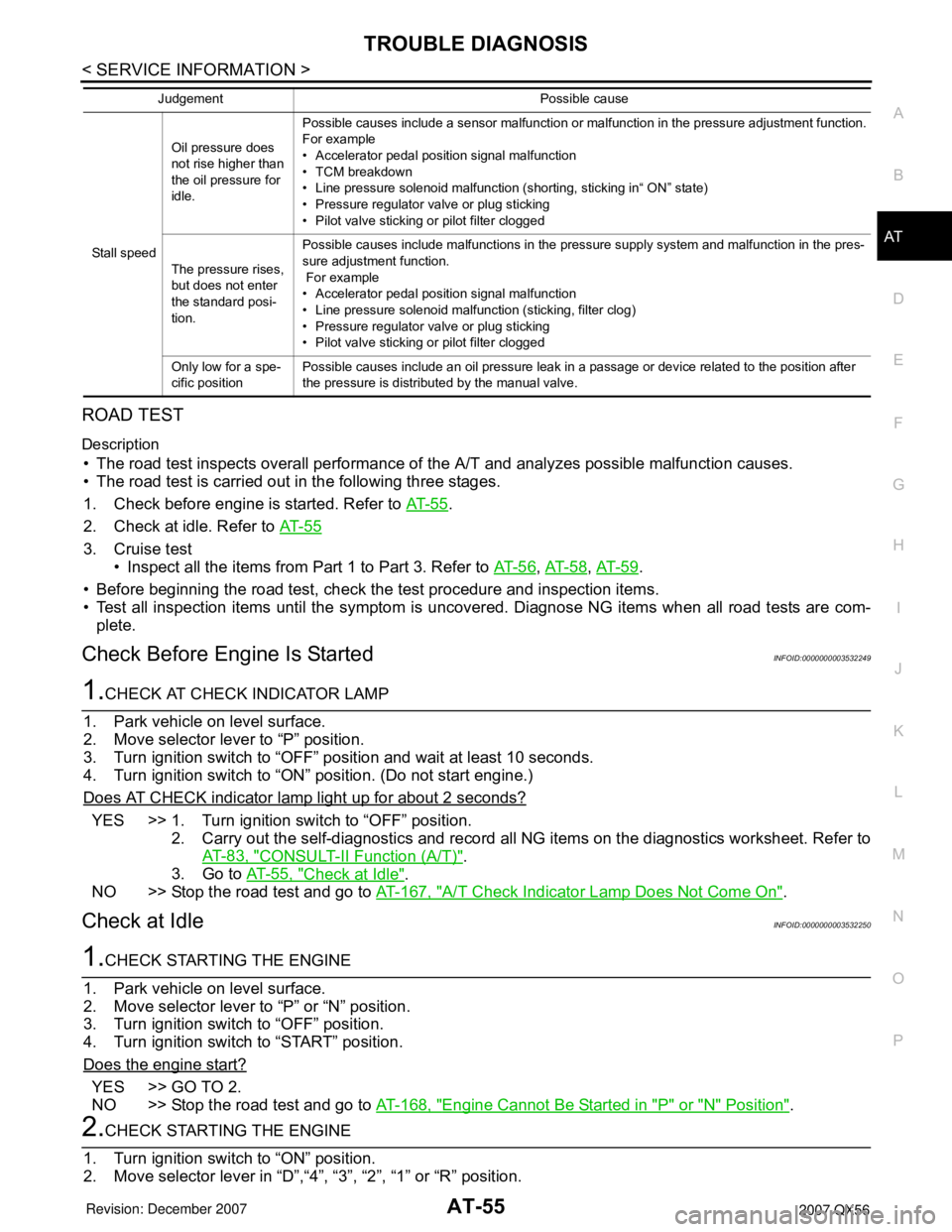
TROUBLE DIAGNOSIS
AT-55
< SERVICE INFORMATION >
D
E
F
G
H
I
J
K
L
MA
B
AT
N
O
P
ROAD TEST
Description
• The road test inspects overall performance of the A/T and analyzes possible malfunction causes.
• The road test is carried out in the following three stages.
1. Check before engine is started. Refer to AT- 5 5
.
2. Check at idle. Refer to AT- 5 5
3. Cruise test
• Inspect all the items from Part 1 to Part 3. Refer to AT- 5 6
, AT- 5 8, AT- 5 9.
• Before beginning the road test, check the test procedure and inspection items.
• Test all inspection items until the symptom is uncovered. Diagnose NG items when all road tests are com-
plete.
Check Before Engine Is StartedINFOID:0000000003532249
1.CHECK AT CHECK INDICATOR LAMP
1. Park vehicle on level surface.
2. Move selector lever to “P” position.
3. Turn ignition switch to “OFF” position and wait at least 10 seconds.
4. Turn ignition switch to “ON” position. (Do not start engine.)
Does AT CHECK indicator lamp light up for about 2 seconds?
YES >> 1. Turn ignition switch to “OFF” position.
2. Carry out the self-diagnostics and record all NG items on the diagnostics worksheet. Refer to
AT-83, "
CONSULT-II Function (A/T)".
3. Go to AT-55, "
Check at Idle".
NO >> Stop the road test and go to AT-167, "
A/T Check Indicator Lamp Does Not Come On".
Check at IdleINFOID:0000000003532250
1.CHECK STARTING THE ENGINE
1. Park vehicle on level surface.
2. Move selector lever to “P” or “N” position.
3. Turn ignition switch to “OFF” position.
4. Turn ignition switch to “START” position.
Does the engine start?
YES >> GO TO 2.
NO >> Stop the road test and go to AT-168, "
Engine Cannot Be Started in "P" or "N" Position".
2.CHECK STARTING THE ENGINE
1. Turn ignition switch to “ON” position.
2. Move selector lever in “D”,“4”, “3”, “2”, “1” or “R” position.
Stall speedOil pressure does
not rise higher than
the oil pressure for
idle.Possible causes include a sensor malfunction or malfunction in the pressure adjustment function.
For example
• Accelerator pedal position signal malfunction
• TCM breakdown
• Line pressure solenoid malfunction (shorting, sticking in“ ON” state)
• Pressure regulator valve or plug sticking
• Pilot valve sticking or pilot filter clogged
The pressure rises,
but does not enter
the standard posi-
tion.Possible causes include malfunctions in the pressure supply system and malfunction in the pres-
sure adjustment function.
For example
• Accelerator pedal position signal malfunction
• Line pressure solenoid malfunction (sticking, filter clog)
• Pressure regulator valve or plug sticking
• Pilot valve sticking or pilot filter clogged
Only low for a spe-
cific positionPossible causes include an oil pressure leak in a passage or device related to the position after
the pressure is distributed by the manual valve. Judgement Possible cause
Page 126 of 3061
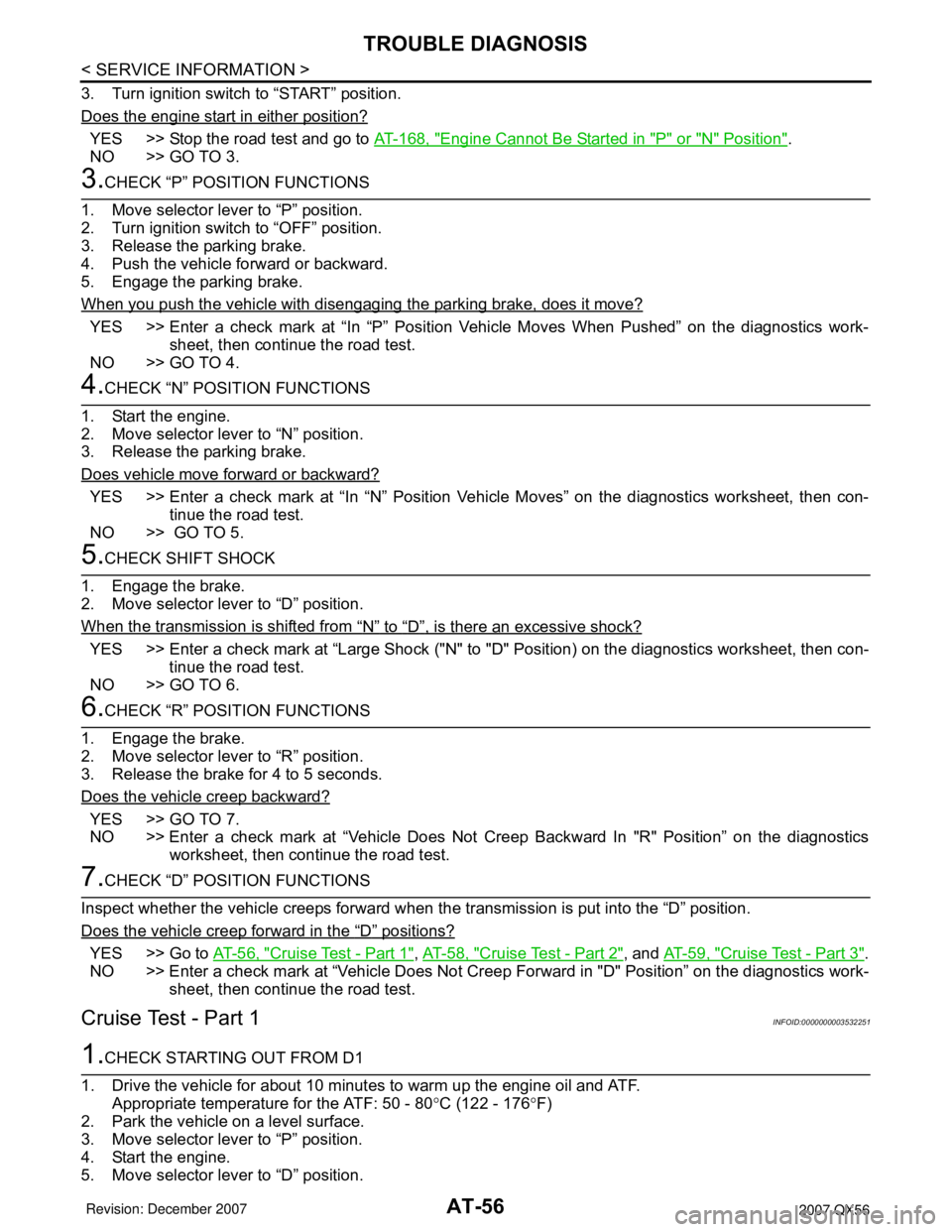
AT-56
< SERVICE INFORMATION >
TROUBLE DIAGNOSIS
3. Turn ignition switch to “START” position.
Does the engine start in either position?
YES >> Stop the road test and go to AT-168, "Engine Cannot Be Started in "P" or "N" Position".
NO >> GO TO 3.
3.CHECK “P” POSITION FUNCTIONS
1. Move selector lever to “P” position.
2. Turn ignition switch to “OFF” position.
3. Release the parking brake.
4. Push the vehicle forward or backward.
5. Engage the parking brake.
When you push the vehicle with disengaging the parking brake, does it move?
YES >> Enter a check mark at “In “P” Position Vehicle Moves When Pushed” on the diagnostics work-
sheet, then continue the road test.
NO >> GO TO 4.
4.CHECK “N” POSITION FUNCTIONS
1. Start the engine.
2. Move selector lever to “N” position.
3. Release the parking brake.
Does vehicle move forward or backward?
YES >> Enter a check mark at “In “N” Position Vehicle Moves” on the diagnostics worksheet, then con-
tinue the road test.
NO >> GO TO 5.
5.CHECK SHIFT SHOCK
1. Engage the brake.
2. Move selector lever to “D” position.
When the transmission is shifted from
“N” to “D”, is there an excessive shock?
YES >> Enter a check mark at “Large Shock ("N" to "D" Position) on the diagnostics worksheet, then con-
tinue the road test.
NO >> GO TO 6.
6.CHECK “R” POSITION FUNCTIONS
1. Engage the brake.
2. Move selector lever to “R” position.
3. Release the brake for 4 to 5 seconds.
Does the vehicle creep backward?
YES >> GO TO 7.
NO >> Enter a check mark at “Vehicle Does Not Creep Backward In "R" Position” on the diagnostics
worksheet, then continue the road test.
7.CHECK “D” POSITION FUNCTIONS
Inspect whether the vehicle creeps forward when the transmission is put into the “D” position.
Does the vehicle creep forward in the
“D” positions?
YES >> Go to AT-56, "Cruise Test - Part 1", AT-58, "Cruise Test - Part 2", and AT-59, "Cruise Test - Part 3".
NO >> Enter a check mark at “Vehicle Does Not Creep Forward in "D" Position” on the diagnostics work-
sheet, then continue the road test.
Cruise Test - Part 1INFOID:0000000003532251
1.CHECK STARTING OUT FROM D1
1. Drive the vehicle for about 10 minutes to warm up the engine oil and ATF.
Appropriate temperature for the ATF: 50 - 80°C (122 - 176°F)
2. Park the vehicle on a level surface.
3. Move selector lever to “P” position.
4. Start the engine.
5. Move selector lever to “D” position.
Page 138 of 3061

AT-68
< SERVICE INFORMATION >
TROUBLE DIAGNOSIS
22
Slips/Will
Not En-
gageWhen “D” position, re-
mains in 5th gear.ON vehicle1. Fluid level and stateAT- 5 1
2. Vehicle speed sensor A/T and vehicle speed sensor MTRAT- 1 0 5,
AT- 1 2 4
3. ATF pressure switch 1 and front brake solenoid valveAT- 1 5 0
,
AT- 1 3 4
4. Line pressure testAT- 5 1
5. CAN communication lineAT- 9 1
6. Control valve with TCMAT- 2 1 0
OFF vehicle7. Front brake (brake band)AT- 2 4 08. Input clutchAT- 2 6 2
9. Gear systemAT- 2 2 8
10. High and low reverse clutchAT- 2 7 2
23Vehicle cannot be
started from D
1.
Refer to AT-177, "
Ve -
hicle Cannot Be Start-
ed from D1".ON vehicle1. Fluid level and stateAT- 5 1
2. Accelerator pedal position sensorAT- 11 7
3. Line pressure testAT- 5 1
4. CAN communication lineAT- 9 1
5. Control valve with TCMAT- 2 1 0
OFF vehicle6. Torque converterAT- 2 4 0
7. Oil pump assemblyAT- 2 5 8
8. 3rd one-way clutchAT- 2 6 0
9. 1st one-way clutchAT- 2 6 7
10. Gear systemAT- 2 2 8
11. Reverse brakeAT- 2 4 0
12. Forward one-way clutch (Parts behind drum support is im-
possible to perform inspection by disassembly. Refer to AT-
19, AT- 2 0.)AT- 2 4 0
13. Forward brake (Parts behind drum support is impossible
to perform inspection by disassembly. Refer to AT- 1 9
, AT- 2 0.)AT- 2 4 0
24Does not lock-up.
Refer to AT-187, "A/T
Does Not Perform
Lock-up".ON vehicle1. Fluid level and stateAT- 5 1
2. Line pressure testAT- 5 1
3. Engine speed signalAT- 1 0 9
4. Turbine revolution sensorAT- 1 0 3
5. Torque converter clutch solenoid valveAT- 111
6. CAN communication lineAT- 9 1
7. Control valve with TCMAT- 2 1 0
OFF vehicle8. Torque converterAT- 2 4 09. Oil pump assemblyAT- 2 5 8
No. Items Symptom Condition Diagnostic ItemReference
page
Page 139 of 3061
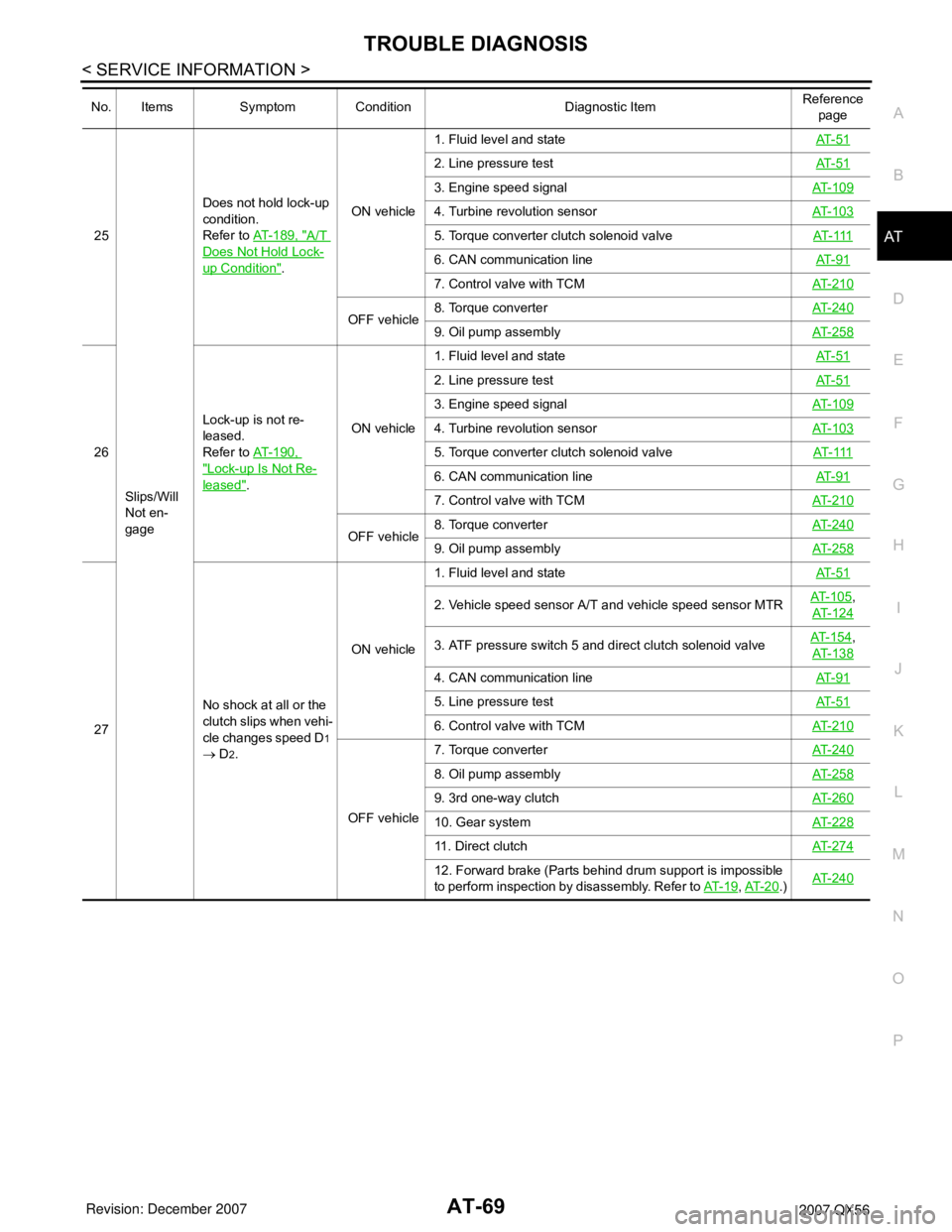
TROUBLE DIAGNOSIS
AT-69
< SERVICE INFORMATION >
D
E
F
G
H
I
J
K
L
MA
B
AT
N
O
P25
Slips/Will
Not en-
gageDoes not hold lock-up
condition.
Refer to AT- 1 8 9 , "A/T
Does Not Hold Lock-
up Condition".ON vehicle1. Fluid level and stateAT- 5 1
2. Line pressure testAT- 5 1
3. Engine speed signalAT-109
4. Turbine revolution sensorAT-103
5. Torque converter clutch solenoid valveAT- 111
6. CAN communication lineAT- 9 1
7. Control valve with TCMAT-210
OFF vehicle8. Torque converterAT-2409. Oil pump assemblyAT-258
26Lock-up is not re-
leased.
Refer to AT- 1 9 0 ,
"Lock-up Is Not Re-
leased".ON vehicle1. Fluid level and stateAT- 5 1
2. Line pressure testAT- 5 1
3. Engine speed signalAT-109
4. Turbine revolution sensorAT-103
5. Torque converter clutch solenoid valveAT- 111
6. CAN communication lineAT- 9 1
7. Control valve with TCMAT-210
OFF vehicle8. Torque converterAT-2409. Oil pump assemblyAT-258
27No shock at all or the
clutch slips when vehi-
cle changes speed D1
→ D
2. ON vehicle1. Fluid level and stateAT- 5 1
2. Vehicle speed sensor A/T and vehicle speed sensor MTRAT- 1 0 5,
AT-124
3. ATF pressure switch 5 and direct clutch solenoid valveAT- 1 5 4,
AT-138
4. CAN communication lineAT- 9 1
5. Line pressure testAT- 5 1
6. Control valve with TCMAT-210
OFF vehicle7. Torque converterAT-240
8. Oil pump assemblyAT-258
9. 3rd one-way clutchAT-260
10. Gear systemAT-228
11. Direct clutchAT-274
12. Forward brake (Parts behind drum support is impossible
to perform inspection by disassembly. Refer to AT- 1 9
, AT- 2 0.)AT-240
No. Items Symptom Condition Diagnostic ItemReference
page
Page 141 of 3061

TROUBLE DIAGNOSIS
AT-71
< SERVICE INFORMATION >
D
E
F
G
H
I
J
K
L
MA
B
AT
N
O
P
30
Slips/Will
Not en-
gageNo shock at all or the
clutch slips when vehi-
cle changes speed D4
→ D
5.ON vehicle1. Fluid level and stateAT- 5 1
2. Vehicle speed sensor A/T and vehicle speed sensor MTRAT- 1 0 5,
AT-124
3. ATF pressure switch 1 and front brake solenoid valveAT- 1 5 0,
AT-134
4. ATF pressure switch 5 and direct clutch solenoid valveAT- 1 5 4,
AT-138
5. CAN communication lineAT- 9 1
6. Line pressure testAT- 5 1
7. Control valve with TCMAT-210
OFF vehicle8. Torque converterAT-240
9. Oil pump assemblyAT-258
10. Front brake (brake band)AT-240
11. Input clutchAT-262
12. Gear systemAT-228
13. High and low reverse clutchAT-272
31When you press the
accelerator pedal and
shift speed D5 → D4
the engine idles or the
transmission slips.ON vehicle1. Fluid level and stateAT- 5 1
2. Vehicle speed sensor A/T and vehicle speed sensor MTRAT- 1 0 5,
AT-124
3. ATF pressure switch 1 and front brake solenoid valveAT- 1 5 0,
AT-134
4. ATF pressure switch 5 and direct clutch solenoid valveAT- 1 5 4,
AT-138
5. CAN communication lineAT- 9 1
6. Line pressure testAT- 5 1
7. Control valve with TCMAT-210
OFF vehicle8. Torque converterAT-240
9. Oil pump assemblyAT-258
10. Input clutchAT-262
11. Gear systemAT-228
12. High and low reverse clutchAT-272
13. Direct clutchAT-274
No. Items Symptom Condition Diagnostic ItemReference
page
Page 142 of 3061

AT-72
< SERVICE INFORMATION >
TROUBLE DIAGNOSIS
32
Slips/Will
Not en-
gageWhen you press the
accelerator pedal and
shift speed D4 → D3
the engine idles or the
transmission slips.ON vehicle1. Fluid level and stateAT- 5 1
2. Vehicle speed sensor A/T and vehicle speed sensor MTRAT- 1 0 5,
AT- 1 2 4
3. ATF pressure switch 3 and input clutch solenoid valveAT- 1 5 2,
AT- 1 3 0
4. ATF pressure switch 1 and front brake solenoid valveAT- 1 5 0,
AT- 1 3 4
5. CAN communication lineAT- 9 1
6. Line pressure testAT- 5 1
7. Control valve with TCMAT- 2 1 0
OFF vehicle8. Torque converter AT- 2 4 0
9. Oil pump assemblyAT- 2 5 8
10. 3rd one-way clutchAT- 2 6 0
11. Gear systemAT- 2 2 8
12. High and low reverse clutchAT- 2 7 2
13. Forward one- way clutch (Parts behind drum support is
impossible to perform inspection by disassembly. Refer to AT-
19, AT- 2 0.)AT- 2 4 0
14. Forward brake (Parts behind drum support is impossible
to perform inspection by disassembly. Refer to AT- 1 9
, AT- 2 0.)AT- 2 4 0
33When you press the
accelerator pedal and
shift speed D3 → D2
the engine idles or the
transmission slips.ON vehicle1. Fluid level and stateAT- 5 1
2. Vehicle speed sensor A/T and vehicle speed sensor MTRAT- 1 0 5,
AT- 1 2 4
3. ATF pressure switch 6, high and low reverse clutch sole-
noid valveAT- 1 5 6,
AT- 1 4 2
4. ATF pressure switch 5 and direct clutch solenoid valveAT- 1 5 4,
AT- 1 3 8
5. CAN communication lineAT- 9 1
6. Line pressure testAT- 5 1
7. Control valve with TCMAT- 2 1 0
OFF vehicle8. Torque converterAT- 2 4 0
9. Oil pump assemblyAT- 2 5 8
10. 3rd one-way clutchAT- 2 6 0
11. Gear systemAT- 2 2 8
12. Direct clutchAT- 2 7 4
13. Forward brake (Parts behind drum support is impossible
to perform inspection by disassembly. Refer to AT- 1 9
, AT- 2 0.)AT- 2 4 0
No. Items Symptom Condition Diagnostic ItemReference
page
Page 143 of 3061

TROUBLE DIAGNOSIS
AT-73
< SERVICE INFORMATION >
D
E
F
G
H
I
J
K
L
MA
B
AT
N
O
P
34
Slips/Will
Not En-
gageWhen you press the
accelerator pedal and
shift speed D2 → D1
the engine idles or the
transmission slips.ON vehicle1. Fluid level and stateAT- 5 1
2. Vehicle speed sensor A/T and vehicle speed sensor MTRAT- 1 0 5,
AT-124
3. ATF pressure switch 5 and direct clutch solenoid valveAT- 1 5 4,
AT-138
4. CAN communication lineAT- 9 1
5. Line pressure testAT- 5 1
6. Control valve with TCMAT-210
OFF vehicle7. Torque converterAT-240
8. Oil pump assemblyAT-258
9. 3rd one-way clutchAT-260
10. 1st one-way clutchAT-267
11. Gear systemAT-228
12. Reverse brakeAT-240
13. Forward one- way clutch (Parts behind drum support is
impossible to perform inspection by disassembly. Refer to AT-
19, AT- 2 0.)AT-240
14. Forward brake (Parts behind drum support is impossible
to perform inspection by disassembly. Refer to AT- 1 9
, AT- 2 0.)AT-240
35With selector lever in
“D” position, accelera-
tion is extremely poor.ON vehicle1. Fluid level and stateAT- 5 1
2. Line pressure testAT- 5 1
3. Accelerator pedal position sensorAT- 11 7
4. CAN communication lineAT- 9 1
5. PNP switchAT- 9 9
6. Control cable adjustmentAT-208
7. Control valve with TCMAT-210
OFF vehicle8. Torque converterAT-240
9. Oil pump assemblyAT-258
10. 1st one-way clutchAT-267
11. Gear systemAT-228
12. Reverse brakeAT-240
13. Forward one- way clutch (Parts behind drum support is
impossible to perform inspection by disassembly. Refer to AT-
19, AT- 2 0.)AT-240
14. Forward brake (Parts behind drum support is impossible
to perform inspection by disassembly. Refer to AT- 1 9
, AT- 2 0.)AT-240
No. Items Symptom Condition Diagnostic ItemReference
page